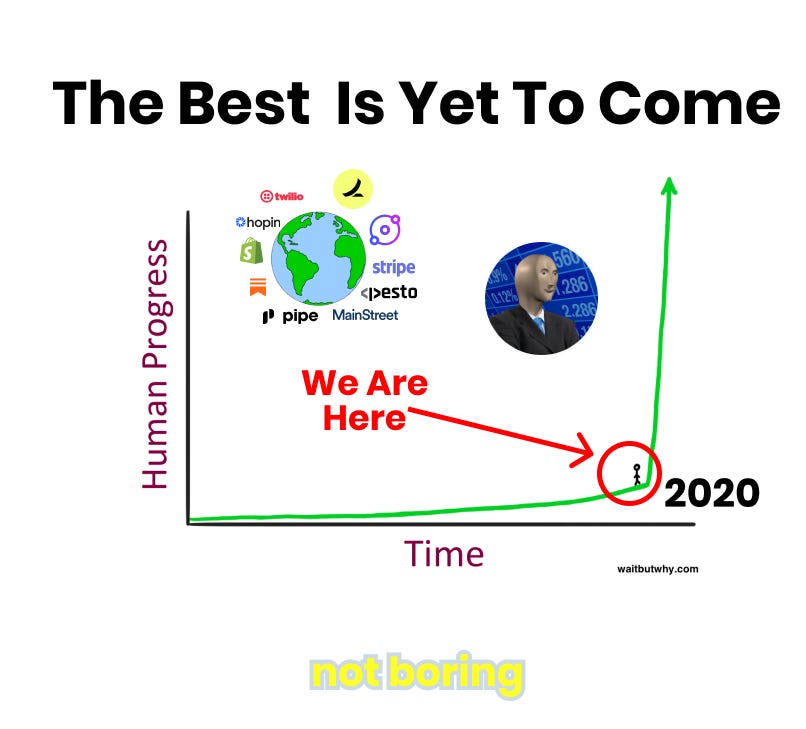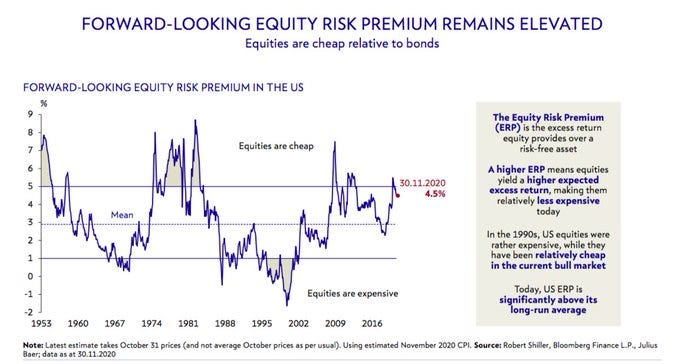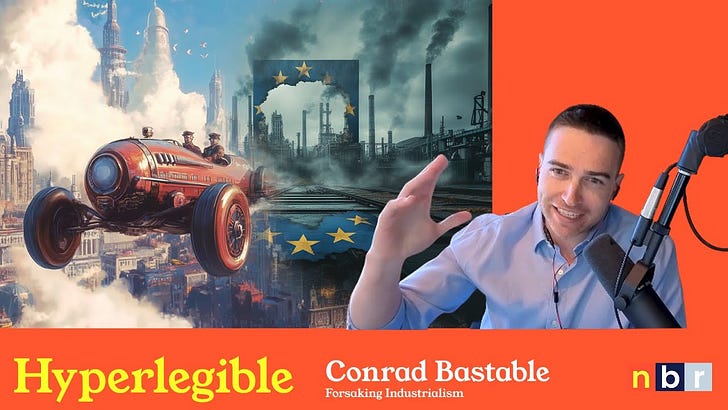Welcome to the 1,383 newly Not Boring people who have joined us since last Monday! If you aren’t subscribed, join 26,835 smart, curious folks by subscribing here!
This week’s Not Boring is brought to you by…
FUSE in an inventory planning solution for the digital age. They help brands efficiently use their working capital by reducing inventory overspend by 70% and stock outs by 10%, freeing up millions of dollars to launch new products and grow their businesses.
Their forecast accurately predicts your demand across all sales channels, marries it to your supply chain data, and tells you how much inventory to order. With FUSE, customers like Snowe Home and True Botanicals spend less time on manual data updates so they can spend more time on strategic initiatives.
Inventory is like porridge. You won't want too much. You don't want too little. You want just the right amount. Don't burn your mouth with reckless inventory orders. Kiss your spreadsheets goodbye and start planning in the cloud.
I’ve been a fan of FUSE for a while, because fun fact: FUSE was my brother and Not Boring editor Dan’s first job out of college. So I can happily say you should schedule a demo:
Hi friends 👋 ,
Happy Monday!
This is the last Not Boring of 2020. It’s a look back on some of the things that have happened in tech and the markets this year, and a look ahead at what impact it all might have.
Looking back at 2020 personally, I am so grateful that I get to write to all of you as my full-time job. In a normal year, it never would have happened.
I can’t help but think the best is yet to come.
Let’s get to it.
The Best Is Yet To Come
I’ve always been an optimist. It’s how I’m wired. My brain has a very hard time visualizing the downsides, and a very easy time visualizing the upsides. So when COVID hit, and millions were losing their jobs, and I made the call to kill the company I had spent six months trying to start, I saw the potential bright spots.
In April’s Schumpeter’s Gale, I wrote that the mass startup layoffs would:
Unlock talent and be the best thing that could have happened to many of the people on those lists [of people laid off and looking for new jobs].
Many people were stuck in “bullshit jobs” at bloated companies that they couldn’t or wouldn’t leave because of inertia or comfort or because too much of their identity was tied up in it. COVID was a reset. It made the decision for them, and freed them up to go start a company, do a job where they were truly valuable, or pursue a passion. It was hard, but ultimately good.
In case that wasn’t sunny enough, in May’s Conjuring Scenius, I wrote:
When it is all said and done, I believe that historians will look back at the Coronavirus pandemic as the greatest catalyst for progress and creativity in human history.
I believed that COVID would unlock creativity and progress and unlock a global form of communal genius by:
Serving as a global catalyzing event for the internet generation, our WWII.
Uniting people around a common mission and shared experience.
Demanding new tools, processes, and social norms for online collaboration.
That’s mostly come true. Eleven months after the first COVID case in the US, we have:
Multiple approved vaccines
Legitimate companies hiring people from around the globe
A generation used to learning online
Increased digital adoption and new channels for previously-offline businesses
New ways of collaborating that previously seemed impossible
We’re more resilient, more anti-fragile than before. Many of the people on the April startup layoff lists have found new jobs at more future-proof companies or are working for themselves, building businesses, communities, and projects that no one can fire them from. Those who still have a day job now have the time to pursue that side thing they’ve been wanting to pursue, and appreciate the power of self-reliance more than ever before.
And for the types of companies that we talk about here at Not Boring, tech companies large and small, things have never been better.
Today, to close out the year, let’s look back at what’s happened and ahead to what it might mean for the future. It’s going to be a bit looser than a normal Not Boring, more letter than essay, but I want to cover three, interrelated themes that, together, make me bullish on tech, company creation, and work:
The Markets Are Eating Up Technology. More demand for tech stocks means more innovation, more quickly. SPACs may be a good thing and IPOs unleash investment in the next generation.
Cloud Companies. Entrepreneurs can build new types of highly-differentiated companies with global talent and increasingly useful software at their fingertips.
The Passion Economy Writ Large. As software does more grunt work and employment becomes more liquid, people will pursue their passions. That will make them even more resilient the next time a crisis hits.
Despite a pandemic that has taken 1.7 million lives, an election that confirmed deep divisions in the United States, and a market that feels a little frothy, I can’t help but think that the next decade is going to be even better than the last.
The Markets Are Eating Up Technology
For more, read: Software is Eating the Markets
I’m even more optimistic today than I was in April and May, because we haven’t just accelerated the adoption of tech, we’ve accelerated the acceleration.
2020 has been a great year to be a techno-optimist. Interest rates are at all-time lows, the Fed is printing money, investors are looking for yield, and tech businesses have become fundamentally stronger as everything stampeded online. DoorDash is a flashing example: its contribution margins improved from -20% in 2019 to positive 23% in 2020.
Every single public company that I’ve written bullishly on is up since I wrote about it, and three have more than doubled.
That’s luck as much as anything. As of this week, the NASDAQ is up 85.93% from its March lows. In 1999, the go-go days of the tech bubble, it increased by just a hair less: 85.59%. There’s never been a better time to write bullish essays on tech companies than from March (when I started doing it) until now.
When I made the mistake of tweeting that 1999 v. 2020 NASDAQ performance stat, people read it as a “this is a bubble” tweet and pointed out that interest rates were much higher in 1999, the dollar is cheaper today, and that stocks aren’t actually expensive right now when looking at Equity Risk Premium, or the spread between the risk-free rate and equity yields:
I agree! I have no idea what the market will do next year, but I don’t think this is a bubble (outside of a few names). I’m willing to bet that over the next five to ten years, owning today’s leading tech companies and investing in the next generation will outperform cash or indices.
To be bearish would be to underestimate exponential acceleration. The “COVID accelerated x trend by 5-10 years” thing that everyone says is too static. It undersells what five to ten years mean these days.
If you believe Ray Kurzweil (do people still believe Kurzweil?) or ARK Invest’s Cathie Wood (hard to argue with Cathie Wood), technology improves at accelerating rates. By pulling certain trends like eCommerce, remote work, online education, and crypto forward by 5-10 years, COVID actually accelerated growth and productivity exponentially, and set a new, higher base off of which even faster-accelerating technology will be built.
ARK’s theses are largely based on Wright’s law, which states that costs decline as more units are produced, which generates more demand, driving costs down further. It’s exponential improvement.
Tim Urban expresses the same general idea without the formula:
Kurzweil, Wood, and Urban would agree: it’s much easier for people to think linearly than exponentially, which causes them to undershoot the future.
Improvements beget improvements. More units drive down costs. Better technology creates better technology. And more money pouring into tech stocks creates better tech companies.
Even after a decade-long bull run, 2020 was somehow tech’s best year since 1999. In the short-term, that’s great for people who own tech stocks. In the medium-term, that’s great for innovation.
Take IPOs as one measure of demand for riskier tech stocks. After a sluggish 2019 for tech IPOs, every member of the 2019 IPO Class is up this year. On average, the group is up 247%.
That opened the window for a new wave of public companies. It’s been a busy year for Mario Gabriele and the S-1 Club. Pexip, Vroom, Lemonade, Rackspace, Unity, Snowflake, Palantir, Asana, Airbnb, DoorDash, and Affirm were among 24 venture-backed companies that went public in 2020. Snowflake, Airbnb, and DoorDash blew their underwriters’ price targets out of the water. Palantir and Unity thrived in their first months as public companies. On the whole, IPOs are outperforming the S&P 500 by 8x YTD.
The SPAC window opened, too. Last year, if you’d asked the average person on the street what a SPAC was, they’d stare at you blankly. Now, they’d list ten they own and ask you to please back away from their Ferrari.
While serious people deride SPACs as Robinhood-trader catnip, the newly-popular financing method serves a purpose. SPACs inject capital into projects previously deemed too risky for the public markets, and lowers the cost of capital for innovation.
SPACs aren’t new. They slowly built up steam prior to 2020. From 2010 through 2019, the number of SPACs grew at a 27% CAGR, from seven in 2010 to 59 last year. But this year, they broke out. In 2020, the number of SPAC IPOs quadrupled.
And it’s not just the volume. SPACs have come out of the shady backwaters of finance and into the mainstream: big names like Bill Ackman and Chamath Palihapitiya are leaders among a growing list of reputable SPAC sponsors, and legitimate companies like DraftKings, Virgin Galactic, and Opendoor chose to access the public markets via SPAC merger instead of IPO.
(Somehow, despite all the activity my ideal SPAC target, Juul, has not been SPAC’d (Post_Market agrees). That may change - Axios just reported that SoftBank is filing to raise $500-600mm via SPAC today to acquire a company they haven’t previously invested in … like Juul?)
Shares of all three companies have … lifted off … since the mergers were announced. DraftKings is leading the pack, up 403% YTD, followed by Opendoor at 259% and Virgin Galactic at 106%.
Those companies’ success legitimized the SPAC process, and opened up the floodgates on both the supply (new SPACs) and demand (investor dollars) sides. With the floodgates open, a host of companies have joined in the party, most notably and controversially, EV companies.
Like Virgin Galactic, EV companies like Nikola, Lordstown, Fisker, and Hylion are essentially pre-revenue public companies. Nikola may be a downright fraud. And yet, people have dumped money into their shares. Certainly, part of the rationale is that people want to catch the next Tesla early, but I think a big piece of it is that people want these products to exist. We want to travel to space and we want to drive futuristic cars and trucks without harming the environment. We’re willing to put our money where our mouth is.
If it feels a little bubbly, well, that’s how innovation happens.
A 2018 paper, Two Centuries of Innovation and Stock Market Bubbles, shows a strong relationship between bubbles and innovation. The paper covers inventions from the steam engine train (1825) to the smartphone (2000). Here’s how it works:
New technologies comes to market,
People get over-excited and pour money into the companies that commercialized them,
The influx of cash accelerates the speed of development and adoption of new technologies,
Even when the bubble ends, the companies that commercialized innovation outperform the market.
Demand for shares of companies taking risks on new technologies is reflexive: more money creates better technology which creates more demand for the stock, and so on. Believing in the product and wanting it to exist actually helps bring it into existence.
Additionally, big, splashy liquidity events and soaring prices pull the next generation of innovation forward, indirectly and directly.
Indirectly, they inspire the next generation of entrepreneurs to take their shot. So many multi-billion dollar companies have been founded within the past decade that creating the next one seems feasible.
Directly, they’ve created thousands of tech millionaires who want to invest in the next generation of unicorns. They’ve seen that it’s possible and that the outcomes can be huge. If their idiot bosses could do it, some young, hungry genius can definitely do it. As one small proof point: in the past few weeks, a wave of people from recently-public tech companies have joined the Not Boring Syndicate and started putting their winnings to work to fund the next generation.
This is how Silicon Valley has worked for the past half century, and the model that every new tech ecosystem tries to emulate: success begets investment begets success begets investment.
With more than 250 live and announced SPACs, and an insatiable demand for IPOs of strong tech companies, there will be exit opportunities galore for companies that create enough traction and buzz. After a decade of increasing time between founding and IPO, I think we’ll see that timeline compress. That will only further accelerate the acceleration, as new millionaires and billionaires invest in the next generation.
It’s not just the money, though, that’s accelerating innovation. Entrepreneurs can now spin up teams comprised of the right people from around the globe and software that’s purpose-built to handle whole, non-core functions.
Cloud Companies
For more, read:We’re Never Going Back, APIs All the Way Down
Geography has always been a rate limiting factor on progress. Now, after ten months of remote interaction, and with a wave of new, remote-first collaboration tools coming to market, it no longer will be. That is going to be an absolutely enormous unlock.
“When it is all said and done, I believe that historians will look back at the Coronavirus pandemic as the greatest catalyst for progress and creativity in human history.”
Many of the most progress-rich periods in history were brought into existence by small groups of people in random places around the globe, like Edinburgh during the Scottish Enlightenment, Florence during the Renaissance, or Silicon Valley over the past half-century. Brain Eno called those flashes of communal genius “scenius.” Throughout history, scenius has been limited by whoever happened to live in, or could afford to move to, a given place in a given time. Pre-COVID, even with billions of people online, we didn’t have the tools or norms necessary to capture the ineffable magic of IRL digitally.
Now we do. We’ve lived through a global remote-first dress rehearsal, and while it’s been bumpy, it’s going to get better. I’m convinced that this next generation of entrepreneurs will create the most fascinating companies that we’ve ever seen, and do it faster than before, based on the simple fact that they have more potential inputs, in terms of tools and talent that they’ve ever had before.
Take Hopin, for example. The virtual events platform, founded in June 2019, is truly remote-first. It hires top talent from anywhere in the world, onboards and manages them in a process built for remote, organizes work around the things that need to get done, and creates its own, remote-first culture-building traditions. In the last 13 months, the company has raised $174 million, and it’s already worth $2.1 billion.
On the 20VC podcast, founder Johnny Boufarhat told Harry Stebbings that the company has been able to scale much faster because it’s remote, and that it was easier to start with a clean-slate as a remote-first company than to try to adapt an in-person company to online.
The new wave of companies being founded today are all starting remote-first. They have a whole new arsenal at their fingertips. To be sure, to take advantage of the opportunity will require that founders be Entropy Wranglers, bringing new order to the new chaos.
Today, companies can hire a developer in India (via Pesto), a designer in Sweden (paid via Panther), and a CFO in New York (supported by Ramp). They’ll work together in a Huddle HQ, and spin up new office space as easily as they open a new Google Doc. They can raise money via AngelList Syndicates, Republic Crowdfunding, or directly from stakeholders via Fairmint CAFE’s. Or better yet, keep their equity and get paid for their recurring revenue upfront with Pipe. They can use Stripe to handle payments, Twilio to handle messaging, Shopify to set up a storefront, Marketerhire to hire a part-time marketer, FUSE to manage inventory, Barrel to build their digital identify, MainStreet to scan for free money. Soon, they might even be able to plug in GPT-3 to write copy or handle low-level tickets. There are some naked plugs for Not Boring sponsors and portfolio companies here, but these are the companies I’m most excited about, because they do all of the things businesses shouldn’t need to worry about.
Cloud companies will be able to focus on building the thing that differentiates them, the thing that their unique combination of talent from around the globe enables them to do differently and better than anywhere else. They’ll go from idea to IPO more quickly, and provide capital and guidance to the next generation of entrepreneurs, anywhere in the world.
At the same time, employment will become more liquid. If software can handle a bunch of the time-consuming grunt work, and face-time is made obsolete, why not let employees provide their uniquely human input for 10 or 20 hours per week on a permanent basis, and for multiple companies? Or just give employees their life back? They’ll save an hour per day commuting, and hours throughout the day not running to meetings across town, or waiting for the conference room. They could spend more time locally, with friends, family, and communities.
They might even be able to work on starting their own thing, however small, on the side.
The Passion Economy Writ Large
When Li Jin wrote about the Passion Economy in October 2019, she couldn’t have had any idea how prescient she was. With the benefit of six more months, in April, I wrote that one path for people laid off from “bullshit jobs” would be:
Passion Economy Businesses: COVID has shown many people the importance of having a skill that they can monetize directly with their followers and audiences. I suspect that we will see a proliferation of one-or-two person creative businesses like newsletters, podcasts, courses, design, and coaching. We will also see these business models evolve.
Back then, I had no idea that this is what I was going to be doing full-time. I thought, if I were lucky, it could be a side hustle that paid the rent and made me sharper. Somehow, eight months later, I’m a full-time newsletter writer doing something that I genuinely love and having more fun than I ever thought I could for something I got paid for.
And it’s not just me. 2020 has been all about people building something, however small, for themselves. Over the weekend, I teamed up with Pulsar to look at the companies and trends that have generated the most buzz on Twitter this year.
Aside from Zoom, the companies whose share of conversation have grown the most this year all have one thing in common: they power the Passion Economy.
Teenagers are becoming millionaires on TikTok. Grownups get paid to stream themselves playing video games on Twitch. This year, Roblox paid out over $250 million to 345,000 people who created games on their platform. Shopify merchants generated $5.1 billion over Black Friday Cyber Monday alone, and Etsy lets craftspeople reach a global audience with unique items. Communities are being built on Discord and governed by social money. Sari just turned a well-organized version of her brain into $30k in one day.
And on Substack, I get to write to you every week, tell the stories of the companies shaping the future, have an ongoing conversation with some of the smartest people I’ve ever met, and invest in the next generation of companies that will one day IPO (or even SPAC!).
This trend is just getting started. Creator platforms, when done right, are fantastic businesses. All of the companies in the chart above spread virally as creators on the platform promote their own work. It’s $0 CAC marketing. And the companies have the results, and valuations, to back it up.
Substack is worth somewhere near $100 million.
OnlyFans just raised at a $1.2 billion valuation.
Discord just raised at a $7 billion valuation.
Roblox and TikTok are preparing to IPO.
Etsy and Shopify are public companies with market caps of $24 billion and $142 billion, respectively
Right now, there are hundreds of entrepreneurs building the next wave of creator platforms, opening up more opportunities for people to do their own thing while making a great living. Not Boring Portfolio company Composer, for example, will one day let anyone start their own mini hedge fund, bringing us full circle. We’ll be able to make a living investing in the companies building the next generation of innovative products. The wheel will spin more quickly.
As more people build their own audiences, distribution, and products, we’ll become even more resilient the next time a crisis hits. Our identities might not be so tied up in our jobs. We’ll have a way to pay rent without waiting for the government to agree. We’ll have autonomy and control.
This is the way the world was heading in early February, but it would have taken a lot longer to get where we are today. Now, after a wild, tragic, scary, inspiring 2020, there’s more money supporting innovation than ever before, entirely new ways to build companies, and more opportunity -- and necessity -- for people to follow their passions than ever before.
So apologies if this whole letter comes off as cheesy, pollyanna-ish, or naive, that’s just how my brain works. I’m unabashedly optimistic.
Look at us. We survived 2020. The best is yet to come.
Thanks to Dan and Puja for editing, this time and all year. You’re the best.
Perfect Strangers is a COVID-19 crisis response non-profit that's delivered nearly 200,000 meals to homebound and vulnerable individuals across the country in partnership with local government emergency response and disaster relief efforts over the last 7 months.
With the holidays in full swing, continuing to support those sheltering-in-place remains critical. Sign up to volunteer, donate, or partner to support during this second wave! If interested in learning more about getting involved or other ways of supporting, reach out to Perfect Strangers founder, Mimi Aboubaker, at mimi@weareperfectstrangers.org.
That’s it for Not Boring in 2020!
So what’s next? First, sleep. I’m taking a little time off for the holidays, with one goal: get a real, long, nap in. Beyond that, every New Year’s Day, I lock myself in a room, reflect on everything that’s happened in the past year and set goals for the next one. Here’s last year’s… a lot has changed. I’m particularly looking forward to this year’s session. There’s a lot to do.
Thanks for helping make this year the best of my life. I can’t wait to see what’s next.
Happy Holidays,
Packy



























